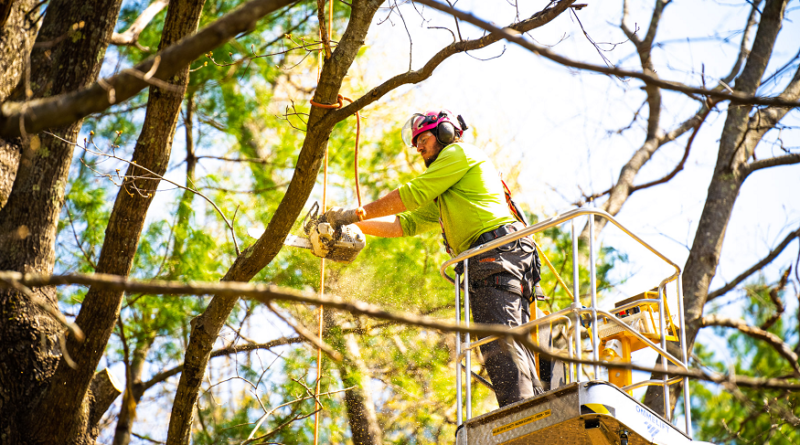Why Tree Pruning Matters More Than You Think
Trees are often seen as symbols of strength and longevity, but like any living thing, they require care to thrive. Left unmanaged, even the healthiest trees can become hazards, eyesores, or simply less vibrant. This is where tree pruning comes in—not just as a maintenance task, but as a vital part of responsible landscaping and long-term tree health.
While it may look like little more than snipping away branches, proper tree pruning is a blend of science, timing, and technique. Done well, it can extend the life of a tree, protect property, and even improve the way sunlight filters through your yard.
Beyond Aesthetics: What Pruning Really Does
To the untrained eye, pruning might seem like a purely cosmetic endeavor. While it does improve appearance, its core purpose is functional. Pruning removes dead, diseased, or structurally unsound branches, which helps trees heal faster and maintain stability. In younger trees, thoughtful pruning shapes growth patterns early on, preventing costly problems years down the line.
For mature trees, structural integrity is everything. A single weakened limb can pose a danger during storms, potentially causing injury or damage. Regular pruning reduces that risk significantly, especially in trees near homes, power lines, or public pathways.
In fruit-bearing trees, pruning has a more agricultural goal: increased yield and better-quality produce. By allowing sunlight and air to reach more parts of the tree, it promotes healthier, more abundant growth.
Timing Is Everything
One of the most overlooked aspects of pruning is timing. While emergency removals can happen anytime, most routine pruning is best done during dormancy—typically late winter or early spring. During this time, trees are less susceptible to disease transmission, and their structure is easier to assess without foliage in the way.
However, not all trees follow the same rules. Flowering species, for example, may require post-bloom pruning to avoid cutting off next season’s buds. A good tree pruning service will take tree type, age, and condition into account before making a single cut.
When DIY Isn’t the Right Call
It can be tempting to tackle pruning yourself, especially for small trees or low-hanging branches. But without the right tools, knowledge, and safety precautions, DIY pruning can lead to unintended consequences. Cutting the wrong limb or making an improper cut can stress a tree, introduce disease, or even destabilize its root system.
Climbing tall trees or using ladders near electrical lines can also be risky. Professional arborists are trained to assess each situation and use specialized equipment to work safely at height. They also know how to make precise cuts that heal cleanly, reducing the chance of decay.
A certified tree pruning service doesn’t just bring tools—they bring insight. They can identify pest damage, fungal infections, or structural weaknesses that the average homeowner might overlook. Their advice often goes beyond trimming to include recommendations for fertilization, soil care, and tree replacement when needed.
Signs Your Tree Needs Pruning
Trees often communicate their needs through visible signs. Here are a few indicators that it might be time to schedule a pruning:
- Dead or broken branches: These pose immediate hazards and should be addressed quickly.
- Crossing or rubbing limbs: Friction between branches can cause wounds that invite disease.
- Unbalanced canopy: A lopsided tree is more prone to wind damage and may require structural correction.
- Excessive shade: Dense canopies limit sunlight and airflow, which can stress the tree and affect understory plants.
- Obstruction: Branches that block walkways, driveways, or windows should be trimmed back for safety and visibility.
Early intervention is always better. Pruning a problem early can prevent expensive removals or treatments later on.
Environmental and Community Benefits
Pruned trees aren’t just safer and healthier—they’re better for the environment too. Healthier trees absorb more carbon dioxide, produce more oxygen, and provide better shelter for wildlife. In urban or suburban settings, a well-maintained tree can help regulate temperatures, reduce erosion, and even raise property values.
From a community standpoint, regular tree maintenance contributes to the overall look and feel of a neighborhood. Streets lined with thriving, well-shaped trees are more inviting and can foster a sense of pride and stewardship among residents.
Choosing the Right Tree Pruning Service
When selecting a professional, look for a service that employs certified arborists and carries insurance. Ask for references, and make sure the company understands local tree species and climate challenges. A reputable tree pruning service will offer a clear plan of action and explain why each cut is necessary.
It’s also worth asking about their approach to tree preservation. The best services take a long-term view, aiming to support the tree’s health and beauty for years rather than just offering a quick trim.
In an age of instant results, tree care requires patience. A thoughtful pruning today could prevent disease, storm damage, or expensive interventions in the future. It’s an investment in both safety and sustainability.
The Long View
Trees are often part of our lives for decades—sometimes centuries. They see seasons change, generations come and go, and neighborhoods transform. Caring for them is both a science and a form of quiet respect. Whether it’s an old oak shading your backyard or a young maple lining your street, a bit of strategic pruning goes a long way.
In the end, tree pruning is not about control. It’s about partnership. When we care for trees, we encourage them to grow stronger, healthier, and more beautifully than they ever could on their own. And in return, they stand tall, offering shade, shelter, and a touch of nature’s wisdom in our everyday lives.

